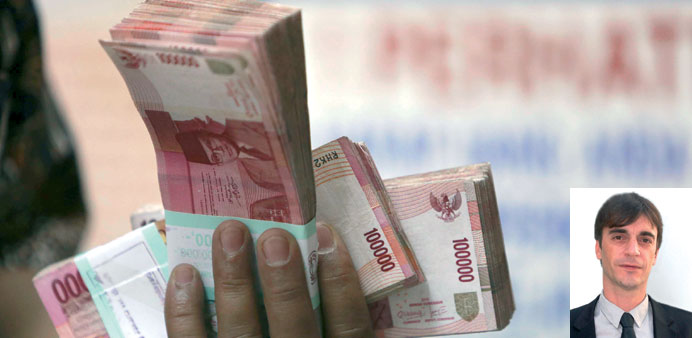A money changer holds stacks of Indonesian rupiah notes in Jakarta. Indonesia saw outflows of $1.3bn over the past seven months after government data showed a widening current
account deficit in the second quarter of 2013.
By Dr Arno Maierbrugger
investvine.com
What is currently happening in Southeast Asia’s economies needs closer attention. It seems that the major nations have hit a speed bump in their economic development, not one that might be unable to overcome, but still a serious one. All this has effects on investors’ sentiment and possible strategies.
Remarkably, the sell-off on Southeast Asian stock exchanges continued in the past week, showing that regional capital markets are in a severe bear market grip. The Philippine’s composite index hit the lowest since November 2012 amid a drastic fall of the peso against the dollar. Jakarta’s Composite Index was down to the lowest since June 2012, and the Thai SET index dropped 2.4% to the lowest since December 2012, taking its year-to-date loss to 9%, tracking Indonesia’s 11% drop for the year, both Asia’s worst performers. Sentiment at Bursa Malaysia also remained weak, with blue chips falling and the benchmark index hitting yet new lows.
The problem will continue until it gets clear what the US Federal Reserve is planning with its quantitative easing programme, and an announcement will be made not earlier as after the bank’s next meeting on September 18. Obviously, the various currencies of Southeast Asia’s economies are overexposed to global money flows, a fiscal phenomenon that caused the European Union to introduce the euro.
Indonesia saw outflows of $1.3bn over the past seven months after government data showed a widening current account deficit in the second quarter of 2013. Malaysia, through its sukuk and other government bonds, is exposed by almost 50% to foreign investors who hold local-currency government bonds. The country will catch a lot of attention when the second-quarter current account, as expected by economists, slips into deficit.
From Thailand, more than $3.3bn in foreign capital has already been taken out this year. The Bank of Thailand has already started tapping into its foreign currency reserves to support the baht which has reached new lows over the past weeks.
The Philippines is also suffering from increased capital outflows, and the peso is already down 8% year. However, the economy is still on a robust growth path, with domestic consumption stoked by massive inflows from Overseas Filipino Workers.
The right strategy for Gulf investors is now to wait and see how the US Fed decides on its global bond buying programme. If emerging Southeast Asian not stabilises thereafter, then there is reason to partly expect a repeat of what happened through the Asian crisis in 1998 unless the countries in questions can’t show that they have learnt something new.
How serious are the fiscal problems in Southeast Asia in your opinion? What should investors do? Is there reason to believe that the region is at the edge of a crisis? Let us know through Twitter: @insideinvestor using hashtag #gulftimes.
Our columnist Dr Arno Maierbrugger is Editor-in-Chief of www.investvine.com, a news portal owned by Inside Investor focusing on Southeast Asian economic topics as well as trade and investment relations between Asean and the GCC. The views expressed are his own.

